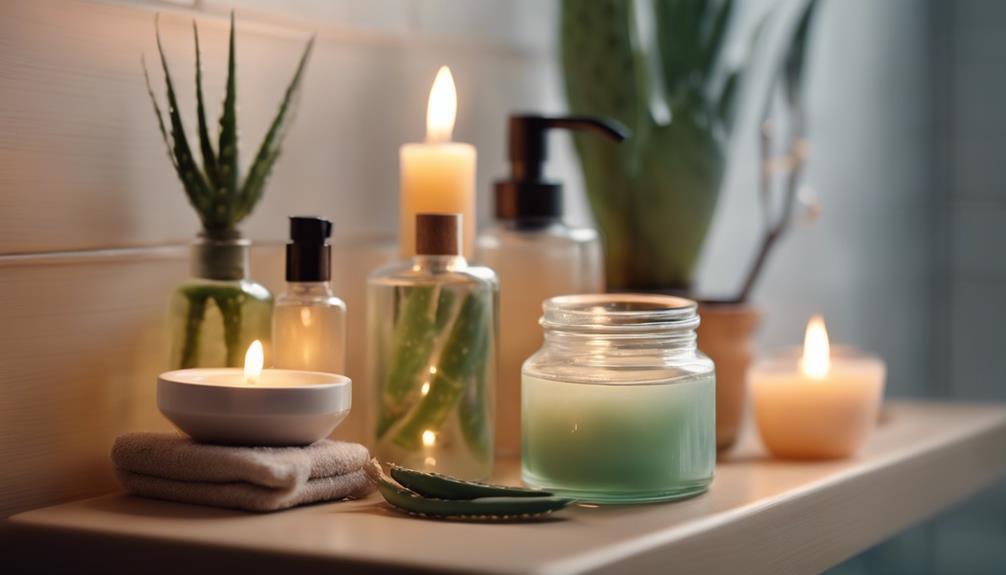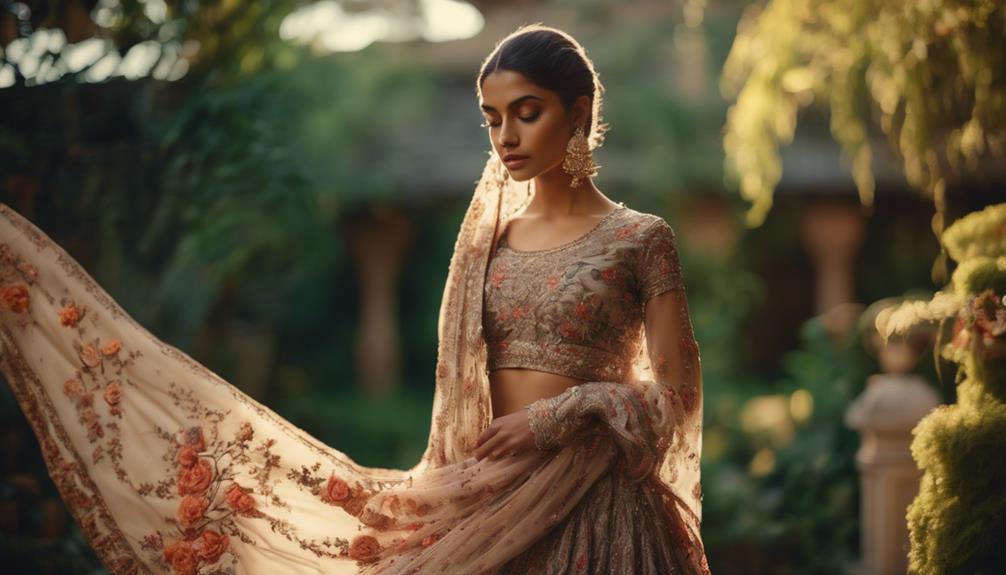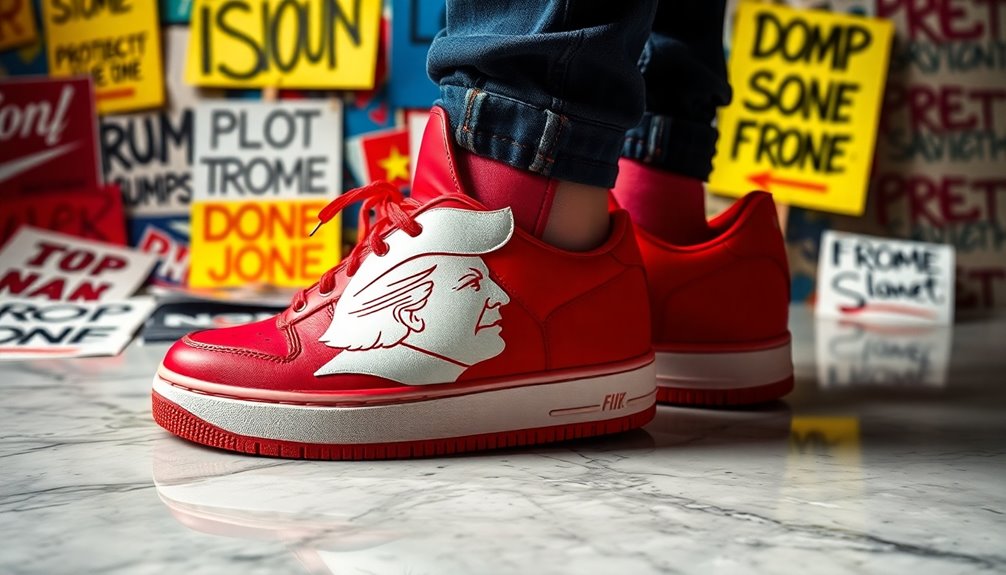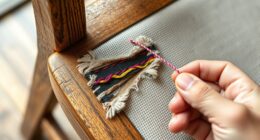The Renaissance fashion era provides a captivating glimpse into a time characterized by creativity and luxury. Emerging in 14th century Italy, these trends focused on uniqueness and social standing, featuring luxurious fabrics such as velvet and brocade. The designs were defined by structured silhouettes, intricate embroidery, and elaborate sleeves, while corsets and dramatic ruffs showcased the beauty ideals of that era. Modern interpretations combine these historical elements with contemporary aesthetics, ensuring that the elegance of the past remains relevant. To learn more about how these exquisite styles influence today’s fashion and get tips on incorporating them into your wardrobe, there is a wealth of information waiting to be discovered!
Key Takeaways
- Renaissance fashion originated in Italy during the 14th century, showcasing wealth through luxurious fabrics like velvet and brocade.
- Key design elements included structured bodices, elaborate sleeves, and corsetry, emphasizing the human form and beauty standards of the time.
- Influential figures like Queen Elizabeth I and Isabella d'Este set enduring fashion trends that are still referenced in modern designs.
- Modern interpretations blend historical aesthetics with contemporary styles, incorporating rich fabrics and dramatic silhouettes inspired by the Renaissance.
Origin and historical background of the fashion trend/style
You'll see how Renaissance fashion transformed from the rigid styles of the Middle Ages into more expressive and intricate designs.
Influenced by artistic movements of the time, clothing became a canvas for showcasing wealth and creativity.
This evolution not only reflected individual status but also marked a significant shift in cultural aesthetics across Europe.
Fashion's Transformation Through Time
Fashion's transformation during the Renaissance showcases a pivotal shift in style, driven by cultural rebirth and social dynamics that influenced clothing choices across Europe. Emerging in Italy during the 14th century, Renaissance fashion marked a departure from the heavy, cumbersome garments of the Middle Ages. Instead, you'll notice intricate designs and luxurious fabrics like silk and velvet that became symbols of status and wealth.
As you explore this era, you'll find that clothing styles were often dictated by social class. Sumptuary laws were established to regulate who could wear specific fabrics and elaborate designs, reinforcing existing social hierarchies. For instance, only the wealthy could afford the ornate lace and embroidery that adorned their garments.
The introduction of more structured silhouettes, such as corsetry for women and the codpiece for men, reflected a growing emphasis on the human form and fashion's role in society. Artistic representations in paintings from this time provide valuable insights into Renaissance fashion trends, revealing how societal influences shaped clothing styles.
Through these changes, fashion not only transformed aesthetic preferences but also reflected the complex social fabric of the Renaissance.
Artistic Movements of the Era
The Renaissance saw a surge of artistic movements that not only transformed visual art but also greatly influenced the fashion trends of the time. Emerging in Italy during the 14th century, these movements, particularly Humanism, emphasized individualism and the human experience. This shift led to more expressive clothing designs that showcased personal identity and social status.
Patrons like the Medici family played a key role in this transformation by commissioning artists to create intricate textile designs and elaborate garments. The flourishing of the arts introduced innovations in painting techniques, such as chiaroscuro, which allowed artists to depict clothing textures and details more realistically. These advancements directly impacted historical fashion, making garments not just practical but also works of art.
Influential figures like Leonardo da Vinci and Raphael contributed to this rich visual culture, embedding fashion elements into their masterpieces that became symbols of wealth and sophistication. As you explore Renaissance fashion, it's evident that the artistic movements of the era were essential in shaping not just how people dressed, but also how they expressed themselves through clothing, forever changing the landscape of historical fashion.
Key Characteristics
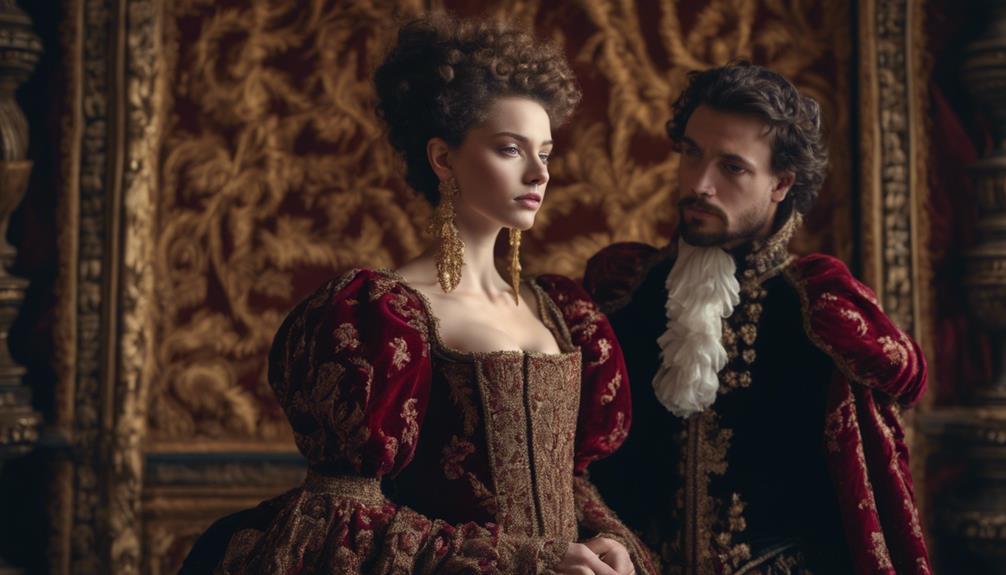
When you think about Renaissance fashion, you can't help but notice the elaborate sleeves and bodices that define the era.
Rich materials like velvet and brocade elevate these designs, creating an opulent look.
Plus, the addition of ruffled necklines adds another layer of intricacy that captures the spirit of the time.
Elaborate Sleeves and Bodices
Elaborate sleeves and structured bodices in Renaissance attire not only highlighted the wearer's wealth but also emphasized the idealized hourglass figure of the era. You'd notice that elaborate gowns often featured sleeves with puffed, slashed, or ruffled designs, creating eye-catching silhouettes. These dramatic features showcased your status and sophistication, making a statement in any gathering.
The bodices of these gowns were typically fitted and structured, sometimes taking on pointed or elongated shapes. This design accentuated your waist and bust, adhering to the beauty standards of the time. Rich fabrics, such as silk and brocade, were the materials of choice, enhancing the overall opulence of the attire.
Intricate embroidery and embellishments adorned both the sleeves and bodices, elevating the elegance of your ensemble. In the late 16th century, corsetry became popular, allowing for an even more defined waistline.
As a result, your gown wouldn't only reflect your wealth but also your understanding of contemporary fashion trends. Colorful, patterned fabrics often contrasted with the bodices, further demonstrating your refined taste and keen sense of style during this remarkable period in history.
Rich Velvet and Brocade
Rich velvet and brocade fabrics defined the luxurious aesthetics of Renaissance fashion, embodying the era's grandeur and sophistication. These materials were more than just textiles; they were a symbol of wealth and social status.
Velvet, crafted from silk or cotton, provided a soft, plush surface that felt as luxurious as it looked. Brocade, with its intricate raised designs, added another layer of visual richness to garments, making them truly eye-catching.
You'd often find these opulent fabrics in Renaissance gowns and doublets worn by the upper class. The elaborate embroidery and embellishments showcased the skill of artisans, highlighting the importance of craftsmanship during this period.
Jewel tones, achieved through natural dyeing methods, became particularly favored because they exuded opulence and vibrancy, making wearers stand out in any gathering.
Additionally, the heavy weight of velvet and brocade contributed to the structured and voluminous silhouettes that defined Renaissance attire. This combination of texture, color, and design reflects the artistic expression and meticulous attention to detail that characterized the fashion of the time, making it a lasting influence on style.
Elaborate Ruffled Necklines
The ruff, a distinctive feature of Renaissance fashion, added a dramatic flair to both men's and women's attire with its intricate pleating and structured design. Made from starched linen or lace, ruffs varied in size, from subtle to extravagant, showcasing the wearer's social status. When you wore a gown adorned with a ruff, it not only framed your neckline beautifully but also enhanced the overall silhouette of your outfit.
Constructing these elaborate necklines required skilled craftsmanship, as artisans employed techniques like pleating and gathering to achieve the desired volume. Ruffs complemented other elements of Renaissance clothing, such as doublets for men, creating a harmonious and sophisticated look.
However, the ruff wasn't just about aesthetics; it also served a practical purpose by protecting the neckline. As fashion evolved, the popularity of ruffled necklines waned by the late 17th century, giving way to simpler collar styles.
Yet, the ruff remains a symbol of the opulence and complexity of Renaissance fashion, reminding us of a time when clothing was both a statement of identity and an art form.
Modern Interpretation
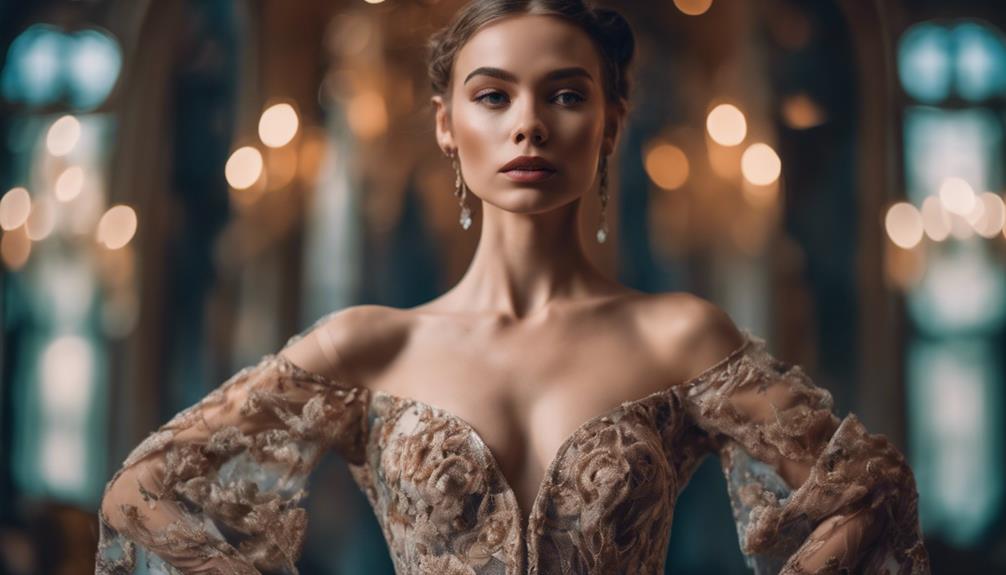
When you look at modern interpretations of Renaissance fashion, you'll notice how contemporary designers blend historical influences with today's aesthetics.
Renowned labels often incorporate regal elements and silhouettes inspired by iconic figures like Queen Elizabeth I, transforming them into fresh, wearable styles.
This fusion not only pays homage to the past but also creates a unique dialogue between eras.
Contemporary Renaissance Fashion Influences
Contemporary fashion embraces Renaissance influences by incorporating luxurious fabrics and dramatic silhouettes that echo the grandeur of the period. You'll notice designers using rich fabrics like velvet and brocade, creating garments that resonate with the opulence of Renaissance attire. These textiles not only look stunning but also feel indulgent against the skin.
Modern collections often adapt the voluminous shapes and exaggerated sleeves characteristic of Renaissance styles, giving them a fresh twist. Corsetry and structured bodices have made a comeback, blending historical elements with contemporary aesthetics. This fusion allows you to experience the elegance of the past while maintaining a modern flair.
Color palettes play a significant role too. Jewel tones, such as emerald, ruby, and sapphire, are making a strong appearance in seasonal collections, bringing a sense of royal sophistication to your wardrobe.
Accessories also reflect this trend, as elaborate jewelry and ornate headpieces inspired by Renaissance styles become more prominent in haute couture.
Renowned Renaissance Fashion Labels
Numerous renowned fashion labels are reinterpreting Renaissance styles, blending historical elements with modern aesthetics to create stunning collections that captivate today's consumers.
You'll find designers drawing inspiration from the opulence of the era, incorporating luxurious fabrics like silk and velvet into their womens fashion lines. The intricate embroidery and embellishments in these collections often pay homage to Renaissance artistry, enhancing their visual appeal.
Fashion houses emphasize sustainability by utilizing ethically sourced materials and adopting made-to-order production techniques, showcasing a commitment to environmental consciousness.
Modern designs frequently feature popular Renaissance motifs, such as puffed sleeves and elaborate headdresses, effectively bridging the gap between historical and contemporary styles.
Collaborations between these fashion labels and historical costume experts have led to authentic recreations of Renaissance attire, allowing you to experience the elegance of the past while embracing modern sensibilities.
As you explore these collections, you'll discover how these renowned fashion labels manage to infuse Renaissance charm into today's womens fashion, offering pieces that resonate with both history and contemporary trends.
This blend creates a unique opportunity for you to express your style while honoring a rich fashion legacy.
Fashion Icons of the Renaissance
Fashion icons like Queen Elizabeth I and Isabella d'Este not only defined the style of their time but also continue to inspire modern interpretations of Renaissance attire.
These women set trends that still resonate in today's fashion, particularly in women's dresses. Elizabeth I's elaborate gowns, rich in jewels and luxurious fabrics, reflect a bold and opulent style that contemporary designers often revisit.
Catherine de Medici's introduction of Italian styles, including corsetry, has led to a resurgence of structured silhouettes in modern fashion. You can see this influence in the tailored dresses that accentuate the waist, reminiscent of the Renaissance era.
Additionally, Isabella d'Este's exquisite taste for unique garments encourages today's fashionistas to seek out one-of-a-kind pieces that showcase individuality and sophistication.
As you explore modern collections, look for puffed sleeves and intricate embroidery—trends that have their roots in Renaissance fashion.
Artistic depictions from that time serve as valuable references, reminding us how these icons shaped societal norms and aesthetics.
Styling Tips
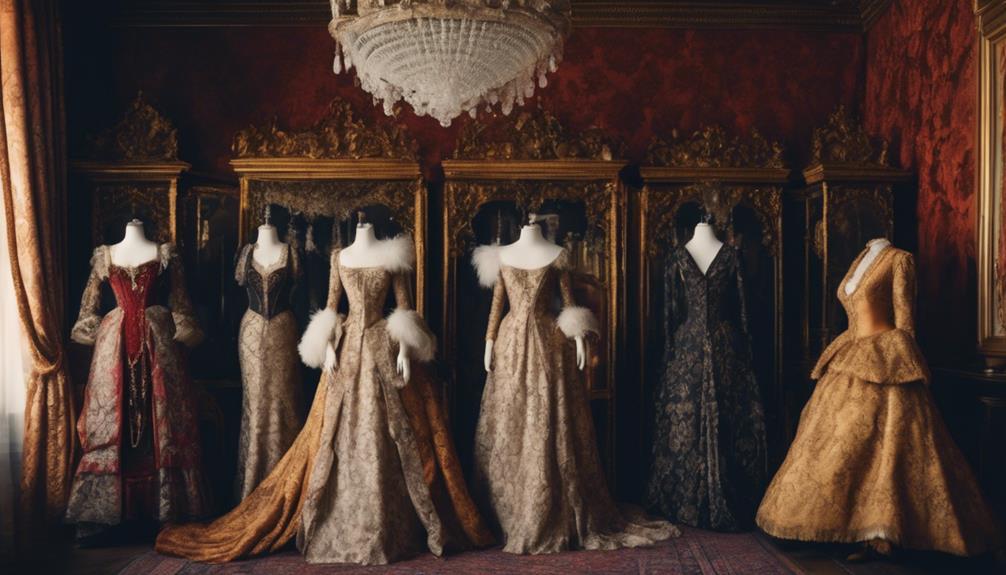
To nail that Renaissance vibe, you'll want to focus on essential accessories and the art of layering.
Corsets and capes can help you create those distinct silhouettes, while mixing textures and patterns adds depth to your outfit.
Keep these styling tips in mind, and you'll embody the elegance of the era.
Essential Renaissance Accessories
Emphasizing your outfit with essential Renaissance accessories, like ornate belts and elaborate headwear, can elevate your look while showcasing your social status and wealth.
Start with an ornate belt, which not only cinches your waist but also adds a touch of opulence. Choose designs adorned with intricate patterns or gemstones to make a statement.
Next, add elaborate headwear—think coifs, caps, or jeweled headdresses. These aren't just fashionable; they also reflect your rank. Look for pieces featuring unique designs and luxurious materials to enhance your overall appearance.
Don't overlook gloves, either. They serve both functional and decorative purposes, often crafted from rich fabrics that display your affluence.
Footwear is equally important; select soft leather shoes embellished with embroidery that mirror your social class while ensuring comfort.
Lastly, consider accessories like embroidered pouches and decorative fans. These not only elevate your ensemble but also blend utility with style, embodying the Renaissance spirit.
Layering With Corsets and Capes
Incorporating corsets and capes into your look not only enhances your silhouette but also adds layers of sophistication and warmth to your Renaissance ensemble.
Corsets are essential for achieving that coveted hourglass figure, tightly lacing your waist while supporting your bust. Opt for corsets adorned with intricate detailing to elevate your style further.
When it comes to layering, capes are a perfect companion. Made from luxurious fabrics like velvet, they bring elegance to your outfit and offer warmth. Look for capes with ornate embroidery or fur trim to make a bold statement. You can cinch the cape at your waist with a stylish belt or jeweled clasp, accentuating your figure while adding a touch of opulence.
To create dynamic looks, combine these pieces to shift from formal events to more casual outings effortlessly. Rich, jewel-toned fabrics in both your corsets and capes can reflect your social status and wealth, staying true to the era's focus on visual indicators of class.
With these tips, you'll master the art of layering and showcase your Renaissance-inspired fashion with confidence.
Layering Textures and Patterns
Mastering the art of layering textures and patterns can transform your Renaissance look into a stunning display of opulence and creativity. Start by selecting a base garment made of luxurious fabric like silk or velvet. Then, layer additional pieces such as brocade or embroidered fabrics to create richness and depth. Aim for three to four layers, as this was typical for wealthy women during the Renaissance.
When combining patterns, don't shy away from mixing different motifs; doing so showcases your artistic flair and historical knowledge. Try pairing a patterned bodice with a solid skirt, and consider adding belts or gloves to enhance your outfit's visual interest. Remember, these accessories not only serve a functional purpose but also elevate your overall look.
Utilizing contrasting colors is key to achieving that striking visual effect characteristic of the era. Experiment with bold hues alongside more subdued tones to emphasize the craftsmanship of your ensemble.
Shopping Guide
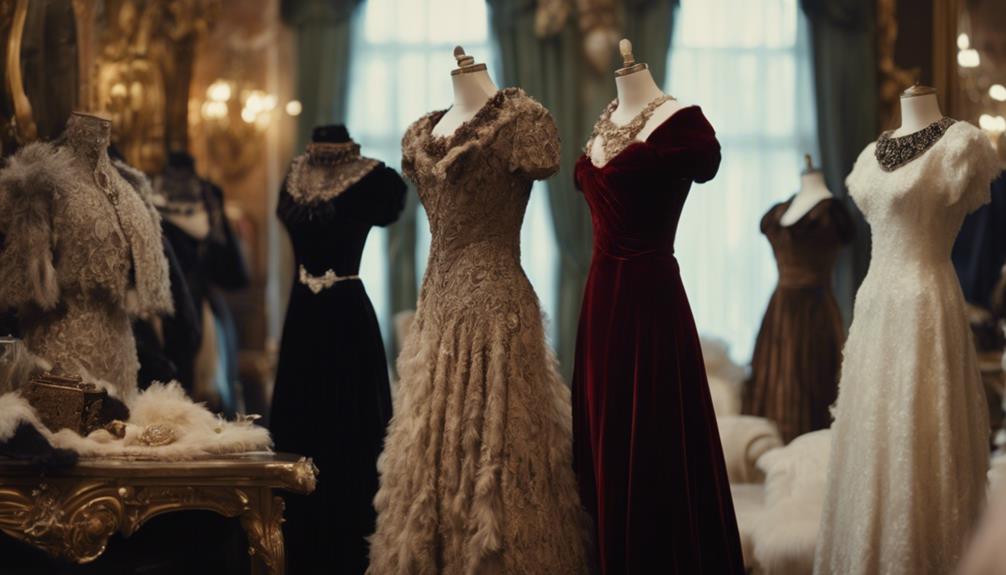
When shopping for Renaissance dresses, you'll find a variety of styles perfect for casual wear, historical reenactments, and Renaissance fairs, all at prices ranging from $75 to $160. These dresses can add a timeless touch to your wardrobe, making them versatile choices for different occasions.
Crafted from 100% vegan materials, these garments emphasize ethical manufacturing and sustainability. You can enjoy high-quality fabric and craftsmanship, knowing each dress undergoes a unique hand-dyeing process, giving you a one-of-a-kind piece. Plus, customization options allow you to express your personal style.
To guarantee the perfect fit, you'll find a detailed size chart available, accommodating regular, petite, and tall sizes for women. This inclusivity means every body type can enjoy these beautiful looks.
Additional benefits include a 60-day hassle-free return policy and free shipping on orders over $99, enhancing your overall shopping experience. With these options, you can feel confident that you're making a thoughtful purchase.
Upcycling Vintage Renaissance Fabrics
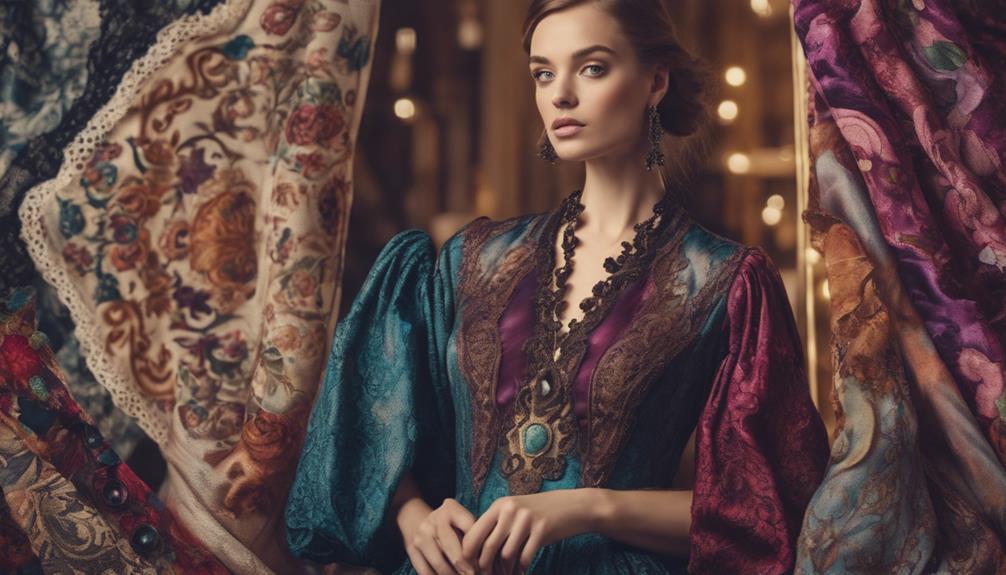
Upcycling vintage Renaissance fabrics lets you breathe new life into antique textiles, transforming them into stunning modern pieces.
By repurposing historical fabric, you not only honor the craftsmanship of the past but also create one-of-a-kind garments that stand out.
This creative process allows you to blend rich history with contemporary style, all while promoting sustainability.
Repurposing Antique Textiles
Repurposing antique textiles allows you to breathe new life into luxurious Renaissance fabrics, transforming them into unique modern garments and accessories. Upcycling vintage materials not only minimizes waste but also preserves the historical significance of these beautiful textiles.
Imagine turning an exquisite piece of silk or brocade into a stunning jacket or a stylish bag that showcases the artistry of the past. The process of upcycling involves various creative techniques, like patchwork, embroidery, and dyeing. You can play with these methods to create one-of-a-kind designs that celebrate the craftsmanship of the original materials.
By incorporating antique textiles into your wardrobe, you not only make a bold fashion statement but also promote sustainability in the fashion industry. Choosing to work with upcycled Renaissance fabrics provides a tangible connection to history, enriching the narrative of your style choices.
Each piece tells a story, allowing you to wear a slice of the past while embracing contemporary fashion. So, immerse yourself in the world of repurposing antique textiles, and let your creativity shine as you give these beautiful fabrics a new lease on life!
Repurposing Historical Fabric Pieces
Transforming vintage Renaissance fabrics into modern pieces not only preserves their intricate beauty but also allows you to make a sustainable fashion choice. By upcycling vintage Renaissance fabrics, you're creatively repurposing historical fabric pieces that often feature luxurious materials like silk and velvet, along with stunning embroidery. This practice embraces the layering techniques used in historical garments, enabling you to reuse multiple fabric layers while showcasing the rich textures and designs that define Renaissance fashion.
When you choose to repurpose these fabrics, you're minimizing waste and promoting a sustainable approach to fashion. Each unique dyeing method, often using natural dyes, can be enhanced through careful restoration, resulting in one-of-a-kind garments that carry stories from the past.
Additionally, by engaging in upcycling vintage Renaissance fabrics, you gain a deeper appreciation for the craftsmanship of earlier eras, as each piece reflects the artistry and skill of its original design.
Ultimately, repurposing historical fabric pieces allows you to create modern apparel that not only looks stunning but also honors the legacy of the Renaissance, all while making an eco-conscious statement.
Cultural Impact

Renaissance fashion's cultural impact is evident in how it inspires film costumes today, bringing historical themes to life on screen.
You'll also notice its influence in modern feminist movements, where clothing choices reflect empowerment and identity.
Understanding this connection reveals how fashion continues to shape and reflect societal values.
Renaissance-Inspired Film Costumes
Renaissance-inspired film costumes play a crucial role in shaping how we perceive elegance and status, as they meticulously recreate the opulence of the era through rich fabrics and intricate detailing. Films like 'Shakespeare in Love' and 'The Other Boleyn Girl' showcase historical accuracy by using luxurious materials such as silk and velvet, highlighting the popular fashion of the time.
Costume designers often reference period portraits and paintings, ensuring that the elaborate embroidery and ornamentation reflect the true essence of Renaissance style. These costumes serve not just as clothing but as visual indicators of social hierarchy, illustrating character identity and status on screen.
The influence of Renaissance fashion in cinema has shaped modern perceptions of elegance and luxury, inspiring contemporary designers to incorporate historical elements into their collections. As you watch these films, consider how the costumes convey deeper meanings about the characters and their societal roles.
Fashion and Feminist Movements
As women began to embrace fashion as a means of self-expression, clothing evolved to reflect their growing independence and challenge traditional societal norms. During the Renaissance, women wore gowns that showcased their individuality, moving away from the restrictive styles that once dominated. This change highlighted their desire for autonomy, both in their personal lives and in society.
Key figures, like Queen Elizabeth I, leveraged fashion as a political tool. Her extravagant gowns symbolized power and independence, inspiring countless women to view their clothing as a medium for self-expression and social commentary. The luxurious fabrics and elaborate designs not only displayed affluence but also served as a declaration of personal agency.
As styles shifted from tight corsets and heavy skirts to more flowing and comfortable garments, women began to assert their identities more freely. This evolution in fashion mirrored the early feminist movements, reflecting a cultural shift towards women's rights and liberation.
Artistic representations from this era often emphasized beauty while challenging traditional roles, further inspiring the feminist narrative. Ultimately, Renaissance fashion laid the groundwork for future generations to embrace clothing as a powerful form of self-advocacy and expression.
Frequently Asked Questions
What Were the Fashion Styles in the Renaissance?
You'd see flowing gowns with high waists and intricate embroidery for women, while men sported puffed sleeves and fitted waists. Accessories like pearls and elaborate headdresses highlighted status, embodying the era's luxurious fashion.
What Are the Different Eras of Clothing?
You'll find different clothing eras, like Medieval with tunics, Renaissance with ornate styles, Regency with empire waistlines, Civil War with lace, and Victorian/Edwardian showcasing evolving silhouettes. Each reflects societal changes and class distinctions.
What Is Considered Renaissance Clothing?
Renaissance clothing features luxurious fabrics like silk and velvet, with fitted bodices for women and doublets for men. Accessories, embroidery, and classical influences define the era's style, showcasing social status and wealth through elaborate designs.
What Were the Clothing Styles Used in Shakespeare's Time?
During Shakespeare's time, you'd see ornate gowns and doublets made from luxurious fabrics. Men wore puffed sleeves and fitted waists, while women donned tight bodices and flowing skirts, showcasing intricate embroidery and elaborate accessories.
What Are the Similarities and Differences Between Renaissance Fashion and 40s Fashion?
Renaissance fashion and classic 40s fashion styles both prioritize elegant and structured silhouettes. However, Renaissance fashion focuses on opulent fabrics and intricate detailing, while 40s fashion emphasizes practicality due to wartime constraints. Both eras exhibit a timeless appeal, showcasing the enduring influence of classic 40s fashion styles.
How Did Italian Fashion Influence Renaissance Fashion?
During the Renaissance, Italian fashion iconic styles were highly influential in shaping the trends of the time. Italian designers and tailors created intricate and luxurious garments that set the standard for elegance and sophistication. These iconic styles became a symbol of status and wealth, and their influence can still be seen in modern fashion.
Conclusion
Incorporating Renaissance fashion into your wardrobe lets you embrace a rich historical legacy while making a bold statement.
By understanding its origins and key characteristics, you can effortlessly blend classic styles with modern trends.
Don't forget to explore sustainable options like upcycling vintage fabrics to create unique pieces.
Whether you're dressing up for an event or adding flair to your everyday look, Renaissance fashion offers endless possibilities for self-expression and creativity.
So, go ahead and make it yours!

